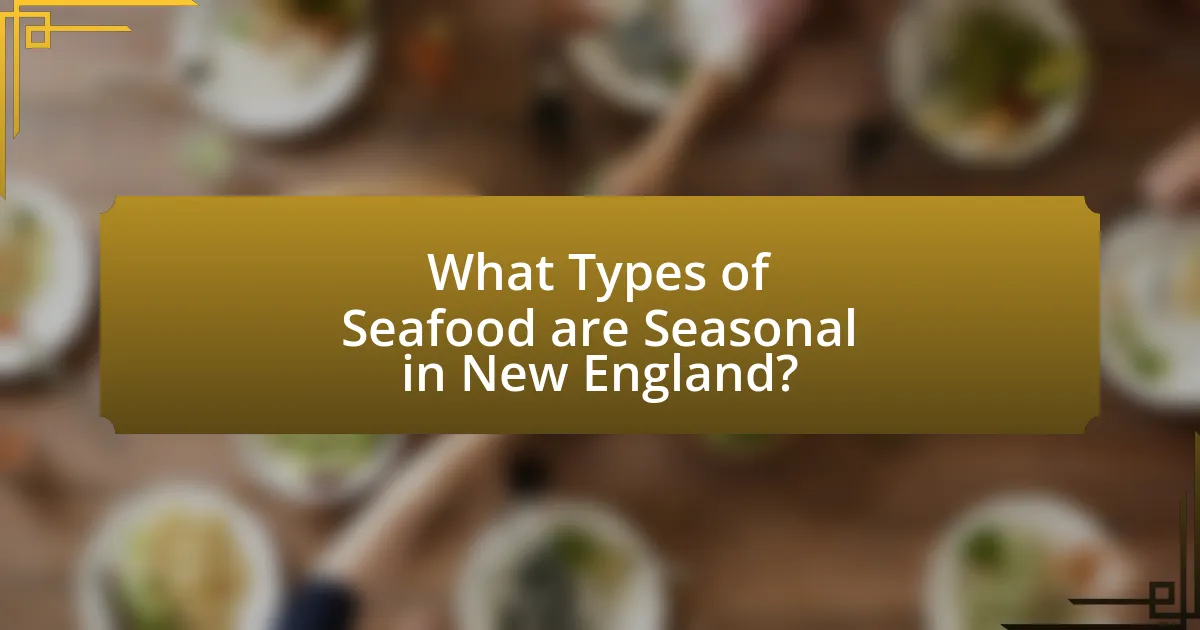Seasonal seafood in New England encompasses various fish and shellfish harvested at specific times of the year, influenced by spawning cycles and fishing regulations. Key species include lobster, scallops, cod, and haddock, each with distinct peak seasons that affect local fisheries and the economy. Environmental factors, such as water temperature and ocean conditions, play a significant role in determining availability, while sustainable fishing practices are essential for maintaining fish populations. The seasonal nature of seafood not only supports local fisheries and restaurants but also enhances tourism, making it a vital component of New England’s culinary and economic landscape.

What is Seasonal Seafood in New England?
Seasonal seafood in New England refers to the variety of fish and shellfish that are harvested during specific times of the year based on their natural spawning cycles and local fishing regulations. For example, species such as lobster are typically in season from late June to late December, while scallops are harvested from November to March. This seasonal availability is influenced by environmental factors and sustainable fishing practices, ensuring that seafood is fresh and abundant during its peak season.
How does the seasonal availability of seafood affect local fisheries?
The seasonal availability of seafood significantly impacts local fisheries by dictating the timing and volume of catch, which directly influences the economic viability of fishing operations. For instance, certain species, such as cod and haddock, are more abundant during specific months, leading to concentrated fishing efforts during those periods. This seasonal pattern can result in fluctuations in income for fishermen, as they may experience peak earnings during high availability seasons and reduced income during off-seasons. Additionally, the seasonal cycles affect the management practices of fisheries, necessitating regulations that align with the reproductive cycles of fish species to ensure sustainability. Studies have shown that fisheries management strategies that consider seasonal availability can lead to healthier fish populations and more stable economic outcomes for local fishing communities.
What factors influence the seasonal patterns of seafood in New England?
The seasonal patterns of seafood in New England are influenced primarily by water temperature, spawning cycles, and fishing regulations. Water temperature affects the distribution and migration of species; for instance, warmer waters in summer lead to increased activity and availability of species like lobster and scallops. Spawning cycles dictate when certain species are more abundant; for example, cod spawn in the spring, making them more available during that season. Additionally, fishing regulations, such as seasonal closures and catch limits, are implemented to protect fish populations and ensure sustainability, further impacting the availability of seafood throughout the year.
How do environmental changes impact seafood seasons?
Environmental changes significantly impact seafood seasons by altering water temperatures, salinity, and nutrient availability, which in turn affect the distribution and life cycles of marine species. For instance, rising ocean temperatures can lead to earlier spawning times for fish species such as cod and haddock, shifting their availability to fishermen. Research conducted by the National Oceanic and Atmospheric Administration (NOAA) indicates that warmer waters have caused a northward migration of several fish species, impacting traditional fishing seasons and practices in New England. Additionally, changes in ocean acidity and nutrient levels can influence the growth of phytoplankton, which serves as the foundational food source for many seafood species, further affecting their populations and seasonal patterns.
Why is seasonal seafood important for New England’s economy?
Seasonal seafood is crucial for New England’s economy because it supports local fisheries, boosts tourism, and generates significant revenue. The fishing industry in New England contributes approximately $1.5 billion annually to the regional economy, with seasonal catches like lobster and scallops being particularly valuable. These seafood products not only provide jobs for thousands of fishermen and related workers but also attract tourists who seek fresh, local dining experiences, further enhancing economic activity in coastal communities.
What role does seasonal seafood play in local restaurants and markets?
Seasonal seafood is crucial for local restaurants and markets as it ensures freshness, supports local economies, and enhances culinary diversity. Fresh, seasonal seafood attracts customers seeking high-quality, sustainable options, which can lead to increased sales for restaurants and markets. In New England, for instance, the availability of species like lobster, scallops, and cod varies throughout the year, allowing establishments to create menus that reflect the best of what local waters offer. This practice not only promotes sustainability by encouraging the consumption of fish that are abundant and in season but also fosters a connection between consumers and local fishermen, thereby strengthening community ties.
How does seasonal seafood contribute to tourism in New England?
Seasonal seafood significantly contributes to tourism in New England by attracting visitors eager to experience local culinary traditions and fresh catches. The region’s reputation for high-quality seafood, such as lobster and clams, draws food enthusiasts and tourists, particularly during peak seasons like summer and fall. According to the National Oceanic and Atmospheric Administration, the commercial fishing industry in New England generates billions in revenue, which directly supports tourism-related activities, including seafood festivals and restaurant dining experiences. This seasonal availability not only enhances the local economy but also promotes cultural experiences tied to fishing communities, making seafood a central element of New England’s tourism appeal.

What Types of Seafood are Seasonal in New England?
In New England, seasonal seafood includes species such as lobster, scallops, clams, and various types of fish like cod and haddock. Lobster season typically runs from late June to late December, while scallops are harvested from late October to March. Clams are available year-round, but peak harvesting occurs in the summer months. Cod and haddock are primarily caught from May to October. These seasonal patterns are influenced by local fishing regulations and the life cycles of the species, ensuring sustainable harvesting practices.
Which seafood species are most commonly harvested seasonally?
The seafood species most commonly harvested seasonally in New England include lobster, scallops, and clams. Lobster is typically harvested from late spring through early fall, with peak catches occurring in July and August. Scallops are harvested primarily in the winter months, while clams are available year-round but see increased harvesting in the warmer months. These seasonal patterns are influenced by factors such as spawning cycles and water temperatures, which affect the availability of these species.
What are the peak seasons for lobster in New England?
The peak seasons for lobster in New England are typically from late spring to early fall, specifically from June to October. During this period, lobsters are most abundant and actively molting, which makes them more accessible for fishing. The peak months, particularly July and August, see the highest catch rates due to favorable water temperatures and increased lobster activity. This seasonal pattern is supported by data from the Atlantic States Marine Fisheries Commission, which indicates that lobster populations thrive in warmer months, leading to increased availability for commercial and recreational fishing.
How does the availability of scallops vary throughout the year?
Scallop availability varies seasonally, with peak harvesting typically occurring from late fall through early spring. Specifically, in New England, the commercial scallop season generally opens in late October and runs until March, aligning with the scallops’ natural spawning cycle, which occurs in the warmer months. During this time, scallops are more abundant and larger, making them more desirable for harvest. The Massachusetts Division of Marine Fisheries reports that the best catches are often seen in January and February, when the scallops are at their largest size and highest quality.
What are the lesser-known seasonal seafood options in New England?
Lesser-known seasonal seafood options in New England include sea urchins, soft-shell clams, and mackerel. Sea urchins, particularly the green and purple varieties, are harvested in the winter and early spring, prized for their roe. Soft-shell clams, also known as steamers, are typically available from late spring through early fall, offering a sweet flavor and tender texture. Mackerel, a migratory fish, is abundant in late summer and early fall, known for its rich taste and high omega-3 fatty acid content. These seafood options are often overshadowed by more popular varieties like lobster and scallops, yet they contribute significantly to the region’s culinary diversity.
How can consumers discover and enjoy these lesser-known seafood types?
Consumers can discover and enjoy lesser-known seafood types by exploring local seafood markets, participating in community-supported fisheries, and attending seafood festivals. Local seafood markets often feature unique offerings that are not available in larger grocery stores, allowing consumers to try new varieties. Community-supported fisheries provide direct access to fresh, seasonal seafood, often highlighting lesser-known species that are sustainably harvested. Seafood festivals frequently showcase diverse seafood options, offering tastings and cooking demonstrations that educate consumers on preparation methods and flavor profiles. These avenues not only promote the enjoyment of lesser-known seafood but also support local fishing communities and sustainable practices.

How Can Consumers Make the Most of Seasonal Seafood?
Consumers can make the most of seasonal seafood by purchasing it during its peak availability, which ensures freshness and optimal flavor. Seasonal seafood in New England includes species like cod, haddock, and lobster, which are typically at their best during specific months. For instance, lobster is most abundant from June to December, while cod is best from late winter to early spring. By aligning their purchases with these seasons, consumers can enjoy seafood at its freshest and often at lower prices due to increased supply. Additionally, supporting local fisheries during these peak times helps sustain the fishing industry and promotes environmentally responsible practices.
What are the best practices for purchasing seasonal seafood?
The best practices for purchasing seasonal seafood include buying from local fisheries, checking for sustainability certifications, and ensuring freshness through sensory evaluation. Local fisheries often provide seafood that is caught at peak season, ensuring optimal flavor and quality. Sustainability certifications, such as those from the Marine Stewardship Council, indicate that the seafood is sourced responsibly, helping to protect marine ecosystems. Freshness can be assessed by examining the appearance, smell, and texture of the seafood; for instance, fresh fish should have clear eyes, bright red gills, and a mild ocean scent. Following these practices supports local economies and promotes sustainable fishing methods.
How can consumers identify fresh, seasonal seafood at markets?
Consumers can identify fresh, seasonal seafood at markets by examining its appearance, smell, and the seller’s knowledge. Fresh seafood typically has clear, bright eyes, shiny skin, and firm flesh. Additionally, it should have a clean, ocean-like smell rather than a strong fishy odor. Knowledgeable sellers can provide information about the seafood’s origin and the seasonality of the catch, which is crucial for ensuring freshness. In New England, for example, species like cod and flounder are more abundant in specific months, aligning with their natural spawning cycles, which consumers can verify through local fishing reports or seafood guides.
What tips can help consumers support sustainable seafood practices?
Consumers can support sustainable seafood practices by choosing seafood certified by reputable organizations like the Marine Stewardship Council or the Aquaculture Stewardship Council. These certifications indicate that the seafood is sourced from fisheries or farms that adhere to sustainable practices, ensuring the health of fish populations and ecosystems. Additionally, consumers should prioritize local seafood to reduce carbon footprints associated with transportation and support local economies. Research shows that local seafood often has a lower environmental impact compared to imported options. Lastly, staying informed about seasonal seafood availability helps consumers make choices that align with sustainable fishing practices, as certain species are more abundant and responsibly harvested during specific times of the year.
How can seasonal seafood be prepared and enjoyed at home?
Seasonal seafood can be prepared and enjoyed at home by utilizing various cooking methods such as grilling, baking, steaming, or sautéing, which enhance the natural flavors of the seafood. For example, fresh New England lobster can be boiled or grilled with butter for a classic taste, while seasonal fish like cod can be baked with herbs and lemon to retain moisture and flavor. Additionally, incorporating seasonal vegetables and local ingredients can elevate the dish, making it more nutritious and flavorful. The freshness of seasonal seafood, often caught within days of consumption, ensures a superior taste and quality, making it a preferred choice for home cooking.
What are some popular recipes featuring seasonal seafood from New England?
Popular recipes featuring seasonal seafood from New England include clam chowder, lobster rolls, and baked stuffed haddock. Clam chowder, a creamy soup made with fresh clams, potatoes, and onions, is a staple in New England cuisine, often enjoyed during the colder months. Lobster rolls, which consist of lobster meat mixed with mayonnaise and served in a toasted bun, highlight the region’s famous lobster catch, particularly in summer. Baked stuffed haddock, typically prepared with breadcrumbs, herbs, and sometimes crab meat, showcases the local haddock fish, commonly available in spring and fall. These recipes reflect the rich seafood tradition of New England, utilizing ingredients that are abundant during their respective seasons.
How can cooking techniques enhance the flavors of seasonal seafood?
Cooking techniques can significantly enhance the flavors of seasonal seafood by utilizing methods that preserve freshness and highlight natural tastes. Techniques such as grilling, steaming, and poaching allow the seafood’s inherent flavors to shine while adding complementary elements like herbs and spices. For instance, grilling can impart a smoky flavor that enhances the sweetness of fish like scallops or swordfish, while steaming retains moisture and delicate flavors, making it ideal for more subtle seafood like flounder. Additionally, poaching in broth or wine can infuse the seafood with additional layers of flavor without overpowering its natural taste. These methods are supported by culinary practices that emphasize the importance of technique in flavor development, as seen in various seafood recipes that prioritize freshness and simplicity to showcase seasonal ingredients.

Leave a Reply